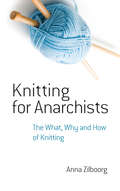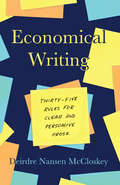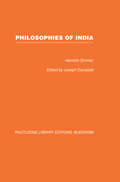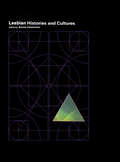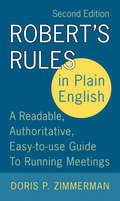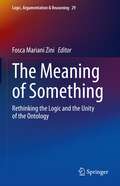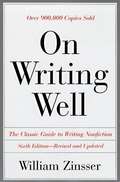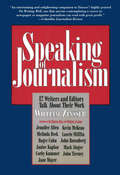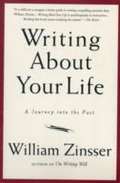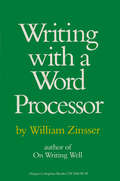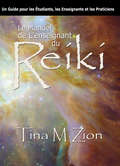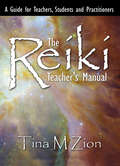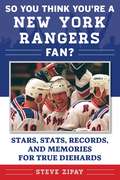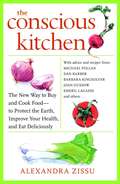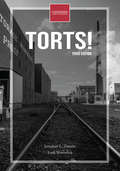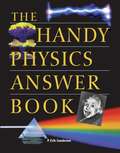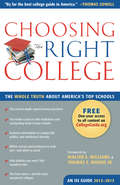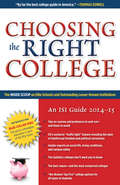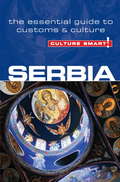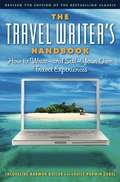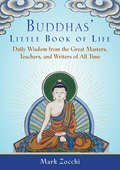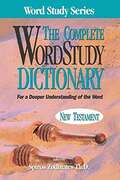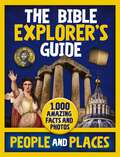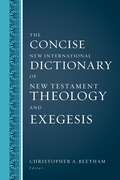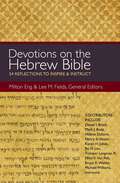- Table View
- List View
Knitting for Anarchists: The What, Why and How of Knitting (Dover Knitting, Crochet, Tatting, Lace)
by Anna ZilboorgEvery knitter takes a different approach, and this revolutionary guide fosters experimentation and self-expression. Author Anna Zilboorg defies the notion of a one-size-fits-all teaching method, assuring readers that the techniques most comfortable and intuitive for individual knitters are always correct. Her explorations of the construction of knitted fabrics are founded upon the understanding that there are many different ways to produce the same satisfying result.Offering advice rather than rules, Knitting for Anarchists promises to broaden the horizons of active knitters and to encourage beginners. Patterns for sweaters, pullovers, and cardigans include helpful photos, charts, and directions that serve not only as guidelines but also as springboards for unlimited variations.
Economical Writing, Third Edition: Thirty-Five Rules for Clear and Persuasive Prose (Chicago Guides to Writing, Editing, and Publishing)
by Stephen T. Ziliak Deirdre N. McCloskeyEconomics is not a field that is known for good writing. Charts, yes. Sparkling prose, no. Except, that is, when it comes to Deirdre Nansen McCloskey. Her conversational and witty yet always clear style is a hallmark of her classic works of economic history, enlivening the dismal science and engaging readers well beyond the discipline. And now she’s here to share the secrets of how it’s done. Economical Writing is itself economical: a collection of thirty-five pithy rules for making your writing clear, concise, and effective. Proceeding from big-picture ideas to concrete strategies for improvement at the level of the paragraph, sentence, or word, McCloskey shows us that good writing, after all, is not just a matter of taste—it’s a product of adept intuition and a rigorous revision process. Debunking stale rules, warning us that “footnotes are nests for pedants,” and offering an arsenal of readily applicable tools and methods, she shows writers of all levels of experience how to rethink the way they approach their work, and gives them the knowledge to turn mediocre prose into magic. At once efficient and digestible, hilarious and provocative, Economical Writing lives up to its promise. With McCloskey as our guide, it’s impossible not to see how any piece of writing—on economics or any other subject—can be a pleasure to read.
Philosophies of India (Routledge Library Editions: Buddhism #9)
by Heinrich ZimmerOriginally published in 1973. The volume is divided into four sections: The introduction places the position of the Buddhist Tantras within Mahayana Buddhism and recalls their early literary history, especially the Guhyasamahatantra; the section also covers Buddhist Genesis and the Tantric tradition. The foundations of the Buddhist Tantras are discussed and the Tantric presentation of divinity; the preparation of disciples and the meaning of initiation; symbolism of the mandala-palace Tantric ritual and the twilight language. This section explores the Tantric teachings of the inner Zodiac and the fivefold ritual symbolism of passion. The bibliographical research contains an analysis of the Tantric section of the Kanjur exegesis and a selected Western Bibliography of the Buddhist Tantras with comments.
Encyclopedia of Lesbian Histories and Cultures: An Encyclopedia (Encyclopedias of Contemporary Culture)
by Bonnie ZimmermanA rich heritage that needs to be documented Beginning in 1869, when the study of homosexuality can be said to have begun with the establishment of sexology, this encyclopedia offers accounts of the most important international developments in an area that now occupies a critical place in many fields of academic endeavours. It covers a long history and a dynamic and ever changing present, while opening up the academic profession to new scholarship and new ways of thinking. A groundbreaking new approach While gays and lesbians have shared many aspects of life, their histories and cultures developed in profoundly different ways. To reflect this crucial fact, the encyclopedia has been prepared in two separate volumes assuring that both histories receive full, unbiased attention and that a broad range of human experience is covered. Written for and by a wide range of people Intended as a reference for students and scholars in all fields, as well as for the general public, the encyclopedia is written in user-friendly language. At the same time it maintains a high level of scholarship that incorporates both passion and objectivity. It is written by some of the most famous names in the field, as well as new scholars, whose research continues to advance gender studies into the future.
Robert's Rules in Plain English 2e
by Doris P. ZimmermanA revised edition of the bestselling Robert's Rules in Plain English, which still stands as the most concise, most-user friendly guide to parliamentary procedure on the market today.If you've ever had to run a meeting according to parliamentary procedures, you know just how difficult it is to keep track of all the rules, much less follow them. Figuring out what to say and how to say it seems an impossible task. Robert's Rules in Plain English, 2nd edition, is the solution to that problem. Not only does it provide you with the essential, basic rules in simple, straightforward English, it also includes summaries, outlines, charts, and sample dialogues so you can see exactly how these rules work in practice.With an extended glossary and new chapters on electronic meetings and internet usage, Robert's Rules in Plain English, 2nd edition, is an authoritative, modern guide to running a meeting successfully and keeping it on track.
The Meaning of Something: Rethinking the Logic and the Unity of the Ontology (Logic, Argumentation & Reasoning #29)
by Fosca Mariani ZiniThis innovative volume investigates the meaning of ‘something’ in different recent philosophical traditions in order to rethink the logic and the unity of ontology, without forgetting to compare these views to earlier significative accounts in the history of philosophy. In fact, the revival of interest in “something” in the 19th and 20th centuries as well as in contemporary philosophy can easily be accounted for: it affords the possibility for asking the question: what is there? without engaging in predefined speculative assumptions The issue about “something” seems to avoid any naive approach to the question about what there is, so that it is treated in two main contemporary philosophical trends: “material ontology”, which aims at taking “inventory” of what there is, of everything that is; and “formal ontology”, which analyses the structural features of all there is, whatever it is. The volume advances cutting-edge debates on what is the first et the most general item in ontology, that is to say “something”, because the relevant features of the conceptual core of something are: non-nothingness, otherness. Something means that one being is different from others. The relationality belongs to something.: Therefore, the volume advances cutting-edge debates in phenomenology, analytic philosophy, formal and material ontology, traditional metaphysics.
On Writing Well: The Classic Guide to Writing Nonfiction (6th edition)
by William ZinsserPrinciples, methods, forms and attitudes necessary to write nonfiction well.
Speaking of Journalism
by William ZinsserVeteran journalist and writing teacher William Zinsser, whose books on writing have sold more than 700,000 copies, presents 11 of his most successful students discussing what it is like to work as a journalist in the 1990s.
Writing About Your Life: A Journey into the Past
by William ZinsserOn Writing Well gives you the tools to organize and recover your past, and the confidence to believe in your life narrative. His method is to take you on a memoir of his own: 13 chapters in which he recalls dramatic, amusing, and often surprising moments in his long and varied life as a writer, editor, teacher, and traveler. Along the way, Zinsser pauses to explain the technical decisions he made as he wrote about his life.
Writing with a Word Processor
by William ZinsserIn this helpful and entertaining book the author of the classic On Writing Well explains that he has always had a love of paper and a fear of mechanical objects. He describes how he confronted his hang-ups, got a word processor, taught himself to use it and gradually overcame his sense of inferiority to the machine. He explains how the word processor--by enabling him to revise his work instantly on a screen--has changed his lifelong methods of writing, rewriting and editing.But William Zinsser's book isn't only for writers. It's for all the people who have to do any kind of writing--memos, letters, reports, directives--as part of their working day. It explains how the word processor will save time and money in an office or a corporation and predicts that it will soon be our primary writing tool.On one level Writing with a Word Processor is a manual for beginners that describes clearly and simply how to use the new technology. But it is also one writer's story. William Zinsser takes the reader along on a highly personal journey, writing with warmth and humor about his anxieties and fears, his setbacks and triumphs. His book is both an informal guide and an encouraging companion.
Le Manuel de L'enseignant du Reiki: Un Guide pour les Étudiants, les Enseignants et les Practiciens
by Tina M. ZionLe Manuel de L'enseignant Reiki fixe les normes pour l'éducation et l'instruction du Reiki. Ce livre est conçu pour les étudiants, les praticiens et les professeurs. Il enrichira les classes que les professeurs actuels enseignent, et donnera au nouveau professeur la confiance et la fièreté lors de la toute première classe. Les praticiens auront une plus grande compréhension de la mise en pratique du Reiki, et de ce qui se passe vraiment lors d'une session. Vous n'aurez plus jamais de peur ni de soucis pour savoir comment enseigner une classe de Reiki, ou donner une harmonisation. Vous serez satisfait et vos élèves seront reconnaissants du riche contenu de vos classes. Le Manuel de l'Enseignant Reiki est un guide graduel et précis pour l'instruction des trois niveaux ou degrés de Reiki. Ce manuel et son format vous fournit: * Un manuel concis qui est facile à utiliser. * Une référence rapide pour répondre aux questions des étudiants. * Des étapes consécutives avec des estimations de temps, pour être sûr que vous enseigniez toutes les informations et ayez encore plein de temps à disposition pour les sessions pratiques. * Comment donner le plus possible à vos étudiants pendant leurs sessions pratiques. * Comment augmenter la puissance de vos harmonisations. * Comment enseigner l'harmonisation aux autres. * Les buts pour différentes parties de chaque classe. * Les descriptions détaillées et utilisations des symboles. * 15 polycopiés qui sont concis et informatifs, et qui peuvent être copiés de ce livre. * Des explications écrites et complètes pour chaque polycopié. * Une liste de fourniture pour chaque niveau et des suggestions pour l'atmosphère de votre classe. * Les grandes lignes pour ouvrir votre propre centre de pratique de Reiki. * Des informations en ce qui concerne l'obtention d'une licence d'état. * Comment éviter les problèmes avec les médecins et la communauté médicale.
The Reiki Teacher's Manual: A Guide for Teachers, Students, and Practitioners (The Reiki Healing Series #1)
by Tina M. ZionThis book is designed for students, practitioners, and teachers. It will enrich the classes that current teachers are giving and gives the new teacher confidence and pride when providing that very first class. Practitioners will have a greater understanding of how to apply Reiki and what is actually happening during a session. You will never again be afraid or even worried about teaching a Reiki class or giving the attunement. You will be pleased and your students will be grateful for the rich content in your classes. "The Reiki Teacher's Manual" is a precise step-by-step guide to instruct all three levels or degrees of Reiki. This manual and its format provide you with: A concise manual that is user friendly; A quick reference to answer student's questions; Consecutive steps with time approximations to make sure you teach all the information and still have plenty of time for the hands on practice sessions. How to get the most for your students during their hands on practice; How to increase the power of your attunement; How to teach the attunement to others; Goals for different segments of each class; Detailed descriptions and uses for the symbols; 15 handouts that are concise, informative, and can be copied from the book; Complete written explanations for each handout; A list of supplies for each level and suggestions for your classroom environment; Guidelines in opening your own Reiki practice; Information regarding state licensing needs; How to avoid issues with physicians and the medical community.
So You Think You're a New York Rangers Fan?: Stars, Stats, Records, and Memories for True Diehards (So You Think You're a Team Fan)
by Steve ZipaySo You Think You’re a New York Rangers Fan? tests and expands your knowledge of Rangers hockey. Rather than merely posing questions and providing answers, you’ll get details behind each—stories that bring to life players and coaches, games and seasons.This book is divided into multiple parts, with progressively more difficult questions in each new section. Along the way, you’ll learn more about the great Rangers players and coaches of the past and present, from Mark Messier to Wayne Gretzky, Rod Gilbert, Bryan Hextall, Vic Hadfield, “Gump” Worsley, Ron Greschner, Andy Bathgate, Jean Ratelle, Eddie Giacomin, Adam Graves, Brad Park, Jaromir Jagr, Mike Richter, Brian Leetch, Henrik Lundqvist, and so many more. Some of the many questions that this book answers include:• Who was the first draftee to actually play for the Blueshirts?• The current Madison Square Garden hosted the first Rangers game on February 18, 1968. Did the Blueshirts win? Who’d they play?• When was the only time an opposing goalie was robustly cheered from the opening faceoff to the end of the game?• Who was the first player of Chinese descent to play in the NHL when he debuted for the Rangers in 1947?• Which unlikely Ranger ended the longest shootout in NHL history? This book makes the perfect gift for any fan of the Blueshirts!
The Conscious Kitchen: The New Way to Buy and Cook Food - to Protect the Earth, Improve Your Health, and Eat Deliciously
by Alexandra ZissuYour everyday food choices can change the world--and make meals taste better than ever For anyone who has read The Omnivore's Dilemma or seen Food, Inc. and longs to effect easy green changes when it comes to the food they buy, cook, and eat, The Conscious Kitchen is an invaluable resource filled with real world, practical solutions. Alexandra Zissu walks readers through every kitchen-related decision with three criteria in mind: what's good for personal health, what's good for the planet, and what tastes great. Learn, among other things, how to: - Keep pesticides, chemicals, and other harmful ingredients out of your diet- Choose when to spend your dollars on organic fruit and when to buy conventionally grown- Avoid plastic--including which kinds in particular and why- Figure out what seafood is safe to eat and is sustainable- Use COOL (country of origin labels) to your advantage- Determine if a vegetable is genetically modified just from reading its PLU (price look up) code- Decipher meat labels in the supermarket- Cook using the least energy--good for the earth and your wallet- Eat locally, even in winter - Understand what "natural" and other marketing terms really mean- Buy packaged foods wisely Navigate farmers' markets, giant supermarkets, and every shop in between to find the freshest and healthiest local ecologically grown and produced meat, dairy, fruits, and vegetables--no matter where you live With The Conscious Kitchen as your guide, you will never again stand in the market bewildered, wondering what to buy. You can feel confident you are making the best possible choices for you, your family, and our planet. ALEXANDRA ZISSU writes about green living, food, and parenthood. She is the author of The Conscious Kitchen, coauthor of The Complete Organic Pregnancy, and contributes the "Ask an Organic Mom" column to The DailyGreen.com. Her stories have appeared in The New York Times, The Green Guide, Cookie, Details, Bon Appétit, Self, and Health, among other publications. She is also a public speaker and "greenproofer," an eco-lifestyle consultant. Visit her website, www.alexandrazissu.com.
Torts!, third edition (The Open Casebook Series)
by Jonathan L. Zittrain Jordi WeinstockA law school casebook that maps the progression of the law of torts through the language and example of public judicial decisions in a range of cases.A tort is a wrong that a court is prepared to recognize, usually in the form of ordering the transfer of money (&“damages&”) from the wrongdoer to the wronged. The tort system offers recourse for people aggrieved and harmed by the actions of others. By filing a lawsuit, private citizens can demand the attention of alleged wrongdoers to account for what they&’ve done—and of a judge and jury to weigh the claims and set terms of compensation. This book, which can be used as a primary text for a first-year law school torts course, maps the progression of the law of torts through the language and example of public judicial decisions in a range of cases. Taken together, these cases show differing approaches to the problems of defining legal harm and applying those definitions to a messy world. The cases range from alleged assault and battery by &“The Schoolboy Kicker&” (1891) to the liability of General Motors for &“The Crumpling Toe Plate&” (1993). Each case is an artifact of its time; students can compare the judges&’ societal perceptions and moral compasses to those of the current era. This book is part of the Open Casebook series from Harvard Law School Library and MIT Press.
The Handy Physics Answer Book
by Paul W ZitzewitzAnswers more than eight hundred questions about physics, ranging from everyday life applications to the latest explorations in the field.
Choosing the Right College 2012–2013
by John ZmirakChoosing the Right College is the most in-depth, independently researched college guide on the market, and the only source for students and parents who want the unvarnished truth about America's top colleges and universities.Updated and expanded, Choosing the Right College 2012-13 features incisive essays, telling statistics, and revealing sidebars on 140 schools--Ivy League institutions, state universities, liberal arts colleges, religious schools, military academies, and lesser-known schools worth a careful look.Here you'll discover information you can't get anywhere else about the intellectual, political, and social conditions at each institution, including:*Insider tips on the best--and worst--departments, courses, and professors*The statistics that colleges don't want you to know*A unique "traffic light" feature--red, yellow, or green--that reveals the state of intellectual freedom and the extent of political correctness on campus*The truth about day-to-day student life: the social scene, living arrangements, campus safety, clubs, sports, traditions, and much more*A roadmap for getting a real education at any school, whether a huge state university or a tiny liberal arts college*Essential financial information, including the extent of need-based financial aid and the average student-debt load of graduates*The most overpriced colleges--and the good values you don't know about "Practically every aspect of university life that a potential student would want to investigate can be found within these pages."--THOMAS E. WOODS JR., Ph.D., bestselling author of Meltdown
Choosing the Right College 2014–15: The Inside Scoop on Elite Schools and Outstanding Lesser-Known Institutions
by John Zmirak"By far the best college guide, for both its honesty and its insights." --Thomas SowellOver the past decade, Choosing the Right College has established itself as the indispensable resource for students--and parents--who want the unvarnished truth about America's top colleges and universities. It is the most in-depth, independently researched college guide on the market, using on-campus sources to turn up the best--and worst--aspects of nearly 150 schools. Just as important, Choosing the Right College covers the intellectual, political, and social conditions that really matter, including:· The integrity and rigor of the curriculum· Which courses and professors to take--and which to avoid· The prevalence of politics in the classroom and the state of free speech--all highlighted with ISI's unique "traffic light"· Living arrangements, safety, and other keys to student life· How to get a real education at any school Beyond all that, this brand-new edition of Choosing the Right College features a host of innovations, including: "So You're Looking For...," top-five lists of colleges for all types of students; a quick list of each school's strengths and weaknesses; an insider's look at the pros and cons of online education; and more. This new edition of Choosing the Right College also provides the financial information families need in this age of soaring tuition. What are the most overpriced colleges--and which are relatively good values? What is the average student-debt load? To cap it all off, Choosing the Right College introduces the groundbreaking feature "Blue Collar Ivies"--in-depth reports on the best affordable colleges in all fifty states. Choosing the Right College 2014-15 will completely change the way young people make a life-altering decision.
Serbia - Culture Smart!
by Lara ZmukicSerbia, a landlocked country at the crossroads of Central and Southeastern Europe, covers the southern part of the Pannonian plain and the central part of the Balkans. The dominant power in the former Yugoslavia, it has had a bad press in the West. However, the truth is much more nuanced and interesting than that portrayed by the media. Serbia is a country with wonderful scenery, architectural riches, and a vibrant arts scene, waiting to be discovered by Westerners. Serbs are proud, passionate, and generous people with an independent streak. They have always had to fight for survival, first against the Ottoman Turks and then against the Habsburg Empire. Following the First World War, they took the lead in forming independent Yugoslavia. They resisted Hitler heroically. Under Tito's rule Yugoslavia steered an independent course. After his death the multinational state disintegrated amid bitter conflict. The war over the secession of the province of Kosovo saw Serbia bombed by NATO forces for two and a half months. The Serbian people's reaction to their hardline Communist regime was the Bulldozer Revolution--a campaign of civil resistance that returned the country to democracy in 2000. Against this turbulent backdrop, the visitor to Serbia needs to be well informed and sensitive to people's feelings. Culture Smart! Serbia introduces you to a diverse, complex, and dynamic society. It offers background information on Serbian history and customs, and essential advice on what to expect and how to behave in different circumstances. If you show interest and respect, you will receive a warm welcome and lasting loyalty in return.
The Travel Writer's Handbook
by Louise Purwin Zobel Jacqueline Harmon ButlerVeteran travel writer Jacqueline Harmon Butler shows readers, one step at a time, how to research, write, and sell travel articles--but most importantly, she details what makes a travel article a winner.In this new edition, Butler updates her bestselling handbook for the 21st century with helpful tips on conducting Internet research, utilizing new advancements in digital photography and finding helpful applications on mobile phones. She also helps aspiring writers navigate the changing world of publishing by exploring blogging, new travel websites, and social media, all while discussing how best to expand your platform.She includes a brand new introduction to reflect the current state of the travel industry and the change in editors' needs. Butler covers all the nuts and bolts aspects of travel writing from pre-trip research, specific marketing strategies, and even includes 12 formats for travel articles with sure-fire appeal to editors and readers. She gives insightful and often humorous advice on pre- and post-trip topics like: How to target your market before you begin How to save time by doing background research before you leave How to write queries and get assignments in advance How to find new angles for overworked subjects What to take along--from video equipment and laptops to travel documents How to set up and conduct successful interviews How to take advantage of freebies and junkets without "selling out" How to sell what you write--and then sell it again
Buddhas' Little Book of Life: Daily Wisdom from the Great Masters, Teachers, and Writers of All Time
by Mark ZocchiInspired by teachings of the Buddha, great masters, teachers, and writers, this is a book designed to help people connect to their inner divinity and find their spiritual path. It is overflowing with profound quotes, sayings, and insights, each presented on its own to allow the reader to dip in randomly and consider one insight at a time. Each reading is guaranteed to immediately inspire or provide food for thought. <P><P>The quotations and sayings have been chosen from Gautama Buddha and other masters of spirituality and inspiration, such as Milarepa, Longchenpa, his Holiness the 14th Dalai Lama, Thich Nhat Hanh, Sogyal Rinpoche, and other greats such as Cicero, Rumi, Lao Tzu, Mother Teresa, and Shakespeare. <P><P>This book is designed to live on your desk, coffee table, or nightstand to provide you with daily comfort, wisdom, and spiritual nourishment. <P><P>“When my house burned down, I gained an unobstructed view of the moon.” —Zen <P><P>“There is no master, there is no instructor, there is no person to tell you what you must do.” —Krishnamurti <P><P>“To abandon what is harmful To adopt what is wholesome To purify the heart and mind: This is the teaching of the Buddha.” —Buddha
The Complete Word Study Dictionary New Testament (Word Study Ser.)
by Spiros ZodhiatesEvery word in the Greek New Testament is explained in great detail, covering all context usages for these words. Numbered to Strong's numbering system, each word has a basic definition and further commentary is provided by Dr. Spiros Zodhiates, noted Greek scholar. A companion Scripture Reference Index is provided for further
The Bible Explorer's Guide People and Places: 1,000 Amazing Facts and Photos
by ZondervanFrom the world&’s leading Bible publisher, comes The Bible Explorer&’s Guide People and Places: 1,000 Amazing Facts and Photos. Packed with fun facts and full-color photos, illustrations, and maps, this book brings to life key Bible characters and places such as:The first people: Adam and EveKings and queens: King Solomon and the Queen of ShebaWarriors: Deborah and SamsonProphets: Elijah and ElishaThe tall and the small: David and GoliathThe ancient worldJerusalemAnd more!The perfect reference for reluctant readers and visual learners interested in discovering the history of the Bible and its people, The Bible Explorer&’s Guide People and Places will fascinate children 8 and up.
The Concise New International Dictionary of New Testament Theology and Exegesis
by ZondervanThe Exegesis Quick-Reference Tool Every Pastor, Teacher, Student, and Scholar NeedsThe Concise New International Dictionary of New Testament Theology and Exegesis (CNIDNTTE) by Christopher A. Beetham is a significant resource for those looking for a quick-reference guide to aid in exegesis and interpretation. It retains all the essentials of the monumental and magisterial New International Dictionary of New Testament Theology and Exegesis edited by Moises Silva, bringing together its most important elements into one accessible volume. This reference includes the most vital, relevant information needed to delve deep into the study of the Greek words used in Scripture for study of the New Testament--its texts and theology.This volume offers a wealth of background and information on the meaning of Greek words in the New Testament, as well as related usage in classical Greek sources, the Greek Old Testament (Septuagint), and extrabiblical Second Temple Jewish literature. This significant tool offers the following features:All the nearly 800 entries covering over 3,000 Greek words found in the full edition are included and presented in the same order and arrangementRetains approximately 60 percent of the original edition, with the emphasis now on synchronic word study and usage in the Greek Old Testament, extrabiblical Second Temple literature, and especially the New TestamentThe unique arrangement according to Greek words and use of English concepts is retained from the full edition and allows all users to access Greek terms regardless of their level of competence in Greek.This edition retains the significant semantic-domain tool that directs the reader to all the Greek words that have something to do with a particular English word or concept. For example, under the English words "Resurrection," there is a list of four Greek words that are related to that topic.Discussions reflect the latest in modern scholarshipBibliographies retain essential references to other standard lexicons and theological dictionariesThe Concise New International Dictionary of New Testament Theology and Exegesis is the ideal tool for pastors, Bible teachers, students, and scholars engaging in exegesis. It is packed with the essential information needed to study the New Testament.
Devotions on the Hebrew Bible: 54 Reflections to Inspire and Instruct
by ZondervanThe main point of each devotion in Devotions on the Hebrew Bible comes from a careful reading of the passage in the Hebrew Bible, not from an English translation—written by some of the top biblical language scholars of today. Contributors include Daniel I. Block, Mark J. Boda, Hélène Dallaire, Nancy Erickson, Karen H. Jobes, Bo H. Lim, Tremper Longman III, Miles V. Van Pelt, Bruce K. Waltke, and Michael Williams, among others. The authors use a variety of exegetical approaches in their devotions—including grammatical, lexical, rhetorical, sociohistorical, and linguistic—and each devotion closes with a practical application or spiritual reflection.Miles Van Pelt, for example, shows that a careful analysis of a grammatical particle in Judges 3:9 elucidates the agent of Israel’s deliverance. Indeed, it is Yahweh who saves! Tremper Longman III explains the role of poetical parallelism in Psalm 1 and highlights how clearly the psalmist invites the reader to introspection, compelling the reader to follow the path of righteousness. And Bo Lim reminds the reader of the biblical precedent for expressing lament. He highlights the poetic artistry of the book of Lamentations, noting its beautiful acrostic, and confirms that both grief and hope provide the rhythm of faith and worship.Devotions on the Hebrew Bible contains a devotion on every book in the Old Testament and can be used as a weekly devotional or as a supplemental resource throughout a semester or sequence of courses. These devotions will inspire you to keep reading and meditating on the Hebrew Scriptures and find new treasures from the biblical text.
